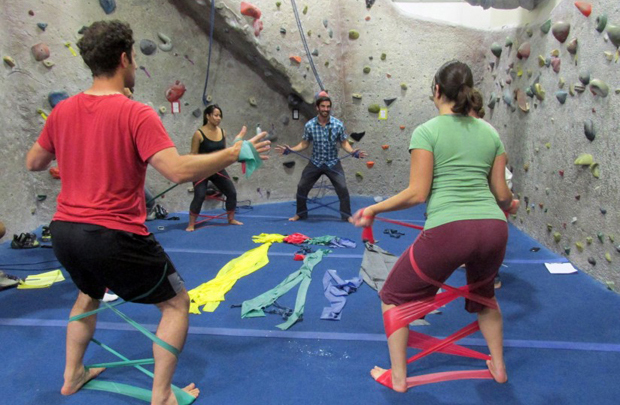Local rock climbers will converge at the newly opened Stronghold Climbing Gym in Los Angeles on April 30 for professional advice from USC physical therapists on how to keep their bodies in climbing shape for years to come.
The goal, according to USC’s Jared Vagy and Jason Kutch, isn’t just to avoid a fall — it’s to climb in a sustainable way that protects the climber’s body from the types of injuries that typically plague longtime rock climbers. The outreach is part of their new initiative to bring hard science to the fast-growing sport of rock climbing.
Long-term injuries — those lingering pains that never quite go away, keeping individuals from doing the activities they love — actually change the way the brain works.
“We now know that the experience of persistent pain reshapes the wiring of the brain,” said Kutch, a climber and assistant professor of biokinesiology and physical therapy at the Ostrow School of Dentistry of USC, whose lab studies the neuroscience of chronic pain. “Our goal is to make climbers mindful of the potential for chronic injury and give them strategies for injury prevention so we can all keep doing what we love.”
His colleague Vagy, a graduate of USC’s Doctor of Physical Therapy program, knows all about those types of injuries. Vagy, who had been a track athlete at the University of California, Davis, discovered climbing when a series of injuries brought his running to a halt.
“Like most climbers, I quickly got addicted,” Vagy said. He moved to Los Angeles in 2006 to pursue his doctorate in physical therapy at USC and simultaneously discovered Southern California’s wide collection of excellent crags at Joshua Tree, Yosemite and elsewhere. He also recently spent six months climbing remote mountains throughout South America, where he was the first to scale a new route in the Peruvian Andes.
Avoiding common climbing ailments
As his passion for climbing grew, so did the number of his injuries. Vagy developed chronic pain in the fingers and rotator cuffs but just kept pushing through it.
“One day, I decided to take what I was learning at USC and apply it to climbing,” he said. “There was no one really out there doing research-based injury prevention for climbers.”
And so Vagy began to tailor his work to address the world of rock climbing. He launched a regular column in the climbing magazine DPM in which he offers tips on proper warmups and how to avoid common climbing ailments.
As word spread, invitations poured in for him to give lectures at climbing festivals throughout the country, such as Red Rocks Rendezvous and Yosemite Facelift, and this year Vagy teamed up with Kutch, a fellow climber, to help get the word out.
One of the key challenges they face is lack of physical therapy research currently in existence on climbing — something that Vagy and Kutch plan to change. Climbing places unique demands on the body that will require study to help create better training and movement strategies.
“Climbing is a quadruped sport. You use your entire body,” Vagy said, noting that more than 44 percent of climbing injuries are in the hand, and yet many of those are caused by improper movements in the lower body.
In an ironic twist, Vagy has repurposed exercises used to help improve the posture of overly sedentary people — office workers, for example — to help climbers ensure that their posture is correct on the wall, protecting their hands from injuries.
Pushing harder can lead to injury
Vagy is collaborating with several climbing gyms throughout Southern California to host injury prevention seminars. These seminars have been sponsored by TheraBand, which is providing resistance bands for attendees.
The plan is to target climbing gyms — not just because that’s a key place for climbers to congregate, but also because that’s where injuries are most likely to happen.
Climbing outside on natural rock, while full of potential dangers, actually leaves the climber a little less injury-prone. This is because, in part, the amygdala (the fear-processing part of your brain) subconsciously tells you to climb a little below your ability level out of the fear of falling and having a big accident, Kutch said.
In a gym, where there are thick pads on the ground and solid anchors on the wall to protect climbers from the frequent falls they take, climbers are more likely to push themselves harder and possibly incur an injury.
The clinic at Stronghold will focus on shoulder health. Vagy and Kutch will begin with a short PowerPoint presentation and then will guide attendees through a variety of exercises.
Those interested in attending can visit the Stronghold Climbing Gym at 650 S. Avenue 21 from 8 to 9 p.m. No registration is required.
More information is available at Vagy’s newly launched website.
—Robert Perkins


